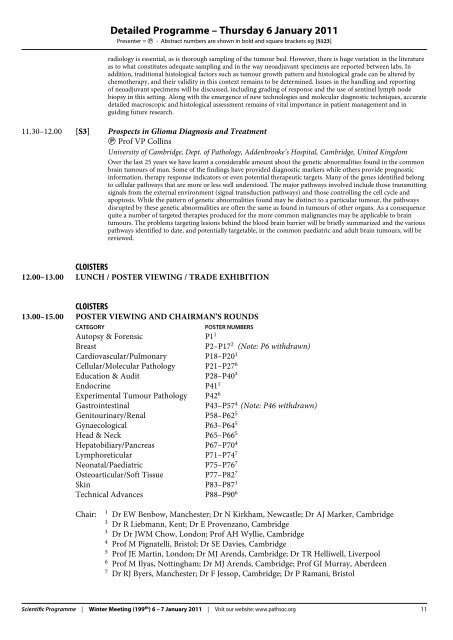Winter Meeting 2011 - The Pathological Society of Great Britain ...
Winter Meeting 2011 - The Pathological Society of Great Britain ...
Winter Meeting 2011 - The Pathological Society of Great Britain ...
Create successful ePaper yourself
Turn your PDF publications into a flip-book with our unique Google optimized e-Paper software.
Detailed Programme – Thursday 6 January <strong>2011</strong><br />
Presenter = P · Abstract numbers are shown in bold and square brackets eg [S123]<br />
radiology is essential, as is thorough sampling <strong>of</strong> the tumour bed. However, there is huge variation in the literature<br />
as to what constitutes adequate sampling and in the way neoadjuvant specimens are reported between labs. In<br />
addition, traditional histological factors such as tumour growth pattern and histological grade can be altered by<br />
chemotherapy, and their validity in this context remains to be determined. Issues in the handling and reporting<br />
<strong>of</strong> neoadjuvant specimens will be discussed, including grading <strong>of</strong> response and the use <strong>of</strong> sentinel lymph node<br />
biopsy in this setting. Along with the emergence <strong>of</strong> new technologies and molecular diagnostic techniques, accurate<br />
detailed macroscopic and histological assessment remains <strong>of</strong> vital importance in patient management and in<br />
guiding future research.<br />
11.30–12.00 [S3] Prospects in Glioma Diagnosis and Treatment<br />
P Pr<strong>of</strong> VP Collins<br />
University <strong>of</strong> Cambridge, Dept. <strong>of</strong> Pathology, Addenbrooke’s Hospital, Cambridge, United Kingdom<br />
Over the last 25 years we have learnt a considerable amount about the genetic abnormalities found in the common<br />
brain tumours <strong>of</strong> man. Some <strong>of</strong> the findings have provided diagnostic markers while others provide prognostic<br />
information, therapy response indicators or even potential therapeutic targets. Many <strong>of</strong> the genes identified belong<br />
to cellular pathways that are more or less well understood. <strong>The</strong> major pathways involved include those transmitting<br />
signals from the external environment (signal transduction pathways) and those controlling the cell cycle and<br />
apoptosis. While the pattern <strong>of</strong> genetic abnormalities found may be distinct to a particular tumour, the pathways<br />
disrupted by these genetic abnormalities are <strong>of</strong>ten the same as found in tumours <strong>of</strong> other organs. As a consequence<br />
quite a number <strong>of</strong> targeted therapies produced for the more common malignancies may be applicable to brain<br />
tumours. <strong>The</strong> problems targeting lesions behind the blood brain barrier will be briefly summarized and the various<br />
pathways identified to date, and potentially targetable, in the common paediatric and adult brain tumours, will be<br />
reviewed.<br />
Cloisters<br />
12.00–13.00 Lunch / Poster viewing / Trade Exhibition<br />
Cloisters<br />
13.00–15.00 Poster viewing and Chairman’s Rounds<br />
CATEGORY<br />
POSTER NUMBERS<br />
Autopsy & Forensic P1 1<br />
Breast<br />
P2–P17 2 (Note: P6 withdrawn)<br />
Cardiovascular/Pulmonary P18–P20 1<br />
Cellular/Molecular Pathology P21–P27 6<br />
Education & Audit<br />
P28–P40³<br />
Endocrine P41 1<br />
Experimental Tumour Pathology P42 6<br />
Gastrointestinal<br />
P43–P57 4 (Note: P46 withdrawn)<br />
Genitourinary/Renal P58–P62 5<br />
Gynaecological P63–P64 5<br />
Head & Neck P65–P66 5<br />
Hepatobiliary/Pancreas P67–P70 4<br />
Lymphoreticular P71–P74 7<br />
Neonatal/Paediatric P75–P76 7<br />
Osteoarticular/S<strong>of</strong>t Tissue P77–P82 7<br />
Skin P83–P87 1<br />
Technical Advances P88–P90 6<br />
Chair:<br />
¹ Dr EW Benbow, Manchester; Dr N Kirkham, Newcastle; Dr AJ Marker, Cambridge<br />
² Dr R Liebmann, Kent; Dr E Provenzano, Cambridge<br />
³ Dr Dr JWM Chow, London; Pr<strong>of</strong> AH Wyllie, Cambridge<br />
4<br />
Pr<strong>of</strong> M Pignatelli, Bristol; Dr SE Davies, Cambridge<br />
5<br />
Pr<strong>of</strong> JE Martin, London; Dr MJ Arends, Cambridge; Dr TR Helliwell, Liverpool<br />
6<br />
Pr<strong>of</strong> M Ilyas, Nottingham; Dr MJ Arends, Cambridge; Pr<strong>of</strong> GI Murray, Aberdeen<br />
7<br />
Dr RJ Byers, Manchester; Dr F Jessop, Cambridge; Dr P Ramani, Bristol<br />
Scientific Programme | <strong>Winter</strong> <strong>Meeting</strong> (199 th ) 6 – 7 January <strong>2011</strong> | Visit our website: www.pathsoc.org<br />
11













